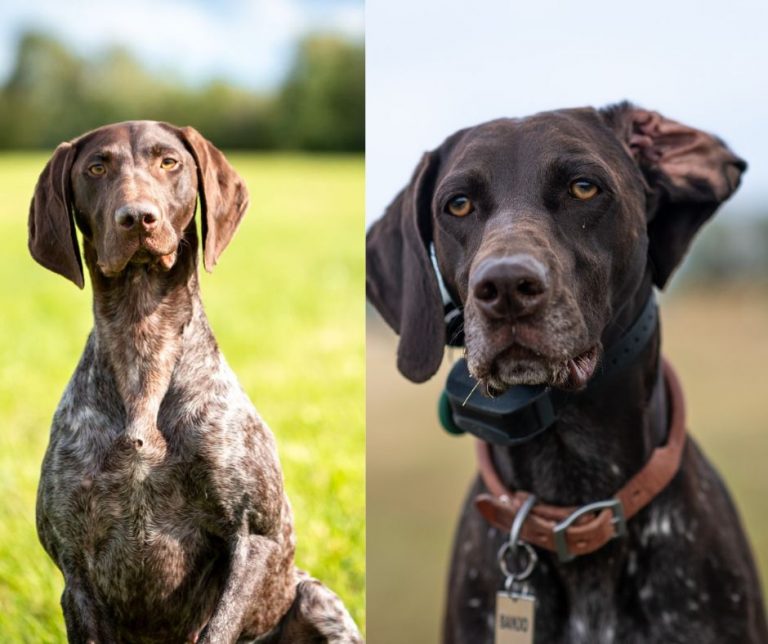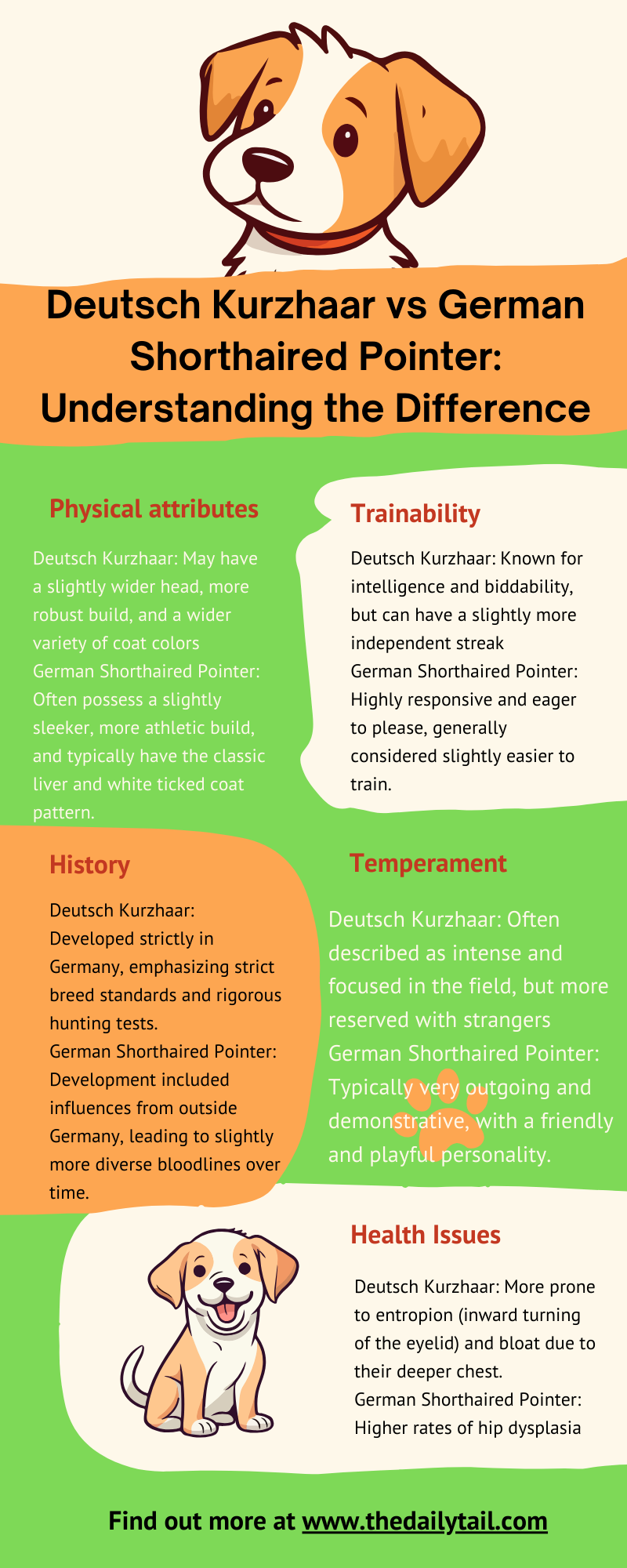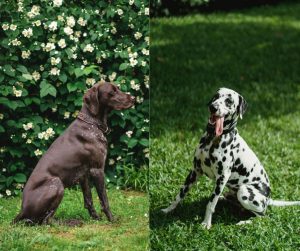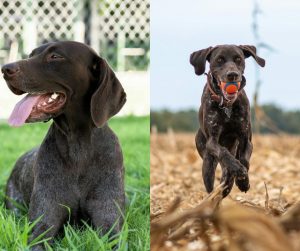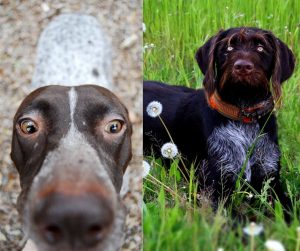The distinction between the Deutsch Kurzhaar vs German Shorthaired Pointer often leads to confusion. Both breeds share a strong heritage as versatile hunting dogs, known for their skills in tracking, pointing, and retrieving. The debate around these two breeds typically revolves around subtle differences that have emerged over time, influenced by breeding practices and regional standards.
In Germany, the Deutsch Kurzhaar has been meticulously bred for performance and conformation to the breed’s standards. The breed is not merely a gun dog but a versatile hunting companion capable of working in various terrains and water conditions. They were originally bred to assist hunters in the field, reflecting their keen sense of smell and remarkable agility.
Conversely, the German Shorthaired Pointer, recognized outside of Germany, has been bred with a focus that often leans more toward American hunting styles.
After three decades of sharing my life with dogs, I thought I knew all there was to know about versatile hunting breeds. Then I encountered the Deutsch Kurzhaar and realized there’s always more to discover – especially when it comes to its close cousin, the German Shorthaired Pointer
This breed shares the same roots as the Deutsch Kurzhaar but has adapted over time to meet the specific needs of hunters in different regions. While they are similar to their German counterparts in many aspects, including appearance, there are nuances in their breeding standards that set them apart.
Origins and History
The German Shorthaired Pointer and the Deutsch Kurzhaar have rich histories with roots deeply embedded in 19th-century Germany. Their origins are intertwined with the country’s cultural development in hunting and dog breeding.
Development of Breeds
The Deutsch Kurzhaar, a German hunting dog, began its development primarily in the 19th century. Its design was to create a versatile hunting companion, capable of various tasks, and was heavily influenced by Germany’s social and political climate after the Franco-Prussian War.
The German Shorthaired Pointer (GSP) is often considered the North American variant of the Deutsch Kurzhaar. Importation of the GSP into the United States dates back to 1925 by Dr. Charles Thornton, who faced initial registration challenges with the American Kennel Club.
Diverging from the Kurzhaar, the GSP was refined in the USA to meet local hunting needs. Both breeds share common ancestors, such as the old Spanish pointer and other continental pointers like the English Pointer and the old German pointer. The breed development aimed to combine the agility of the English Pointer with the power of the older German hunting dogs.
Germany became a breeding hub for these dogs due to a rising middle class of hunters in the newly unified nation. Their desire was for an all-purpose dog: a breed that was as adept at pointing and retrieving as it was obedient and trainable.
The following table provides a summary of the two breeds’ origins:
| Aspect | Deutsch Kurzhaar | German Shorthaired Pointer |
|---|---|---|
| Country of Origin | Germany | Germany (established in the USA) |
| Origin Period | 19th Century | Early 20th Century (established in America) |
| Influential Breeds | Old Spanish Pointer, other traditional continental pointers | Old Spanish Pointer, English Pointer, old German pointer |
| Primary Function | Hunting & Versatility | Hunting & All-Purpose Utility |
The evolution of these breeds mirrors their environments and the roles they were bred to fill, with an emphasis on practicality and versatility in both.
Deutsch Kurzhaar vs German Shorthaired Pointer Breed Characteristics
This section provides an in-depth look at the defining characteristics of the Deutsch Kurzhaar, also known as the German Shorthaired Pointer, covering physical attributes, temperament, behavior, and grooming requirements.
Physical Attributes
The German Shorthaired Pointer (GSP) presents a strong, athletic build with males typically reaching a height of 23 to 25 inches and females standing around 21 to 23 inches. They exhibit a balanced silhouette with a broad chest, and strong back, and are well-known for their distinctive liver or roan coats, often presenting with distinctive white patterns. They possess dark eyes that convey an intelligent and eager expression, moderately long floppy ears, a nose that can vary in color but often blends with their coat, and a muzzle that is long, broad, and strong, aiding their capabilities as hunting dogs.
Temperament and Behavior
German Shorthaired Pointers are characterized by their friendly, obedient, and affectionate nature, making them excellent family pets as well as versatile working dogs. This breed thrives on human companionship and displays a noticeable eagerness to please, which makes them highly trainable. Their high energy levels demand regular exercise and mental stimulation to prevent behavioral issues, and their inherent prey drive requires diligent training to focus their hunting instincts.
Coat and Grooming Requirements
GSPs are adorned with a short and smooth coat that requires minimal grooming. Routine brushing once a week is sufficient to remove loose hair and keep their coat in good condition. The breed’s coat is designed to offer protection from harsh weather, enabling the GSP to perform efficiently during outdoor activities. Maintaining their coat typically involves a straightforward maintenance routine conducive to their active lifestyle.
Health and Longevity
When comparing the Deutsch Kurzhaar and the German Shorthaired Pointer, understanding their health and longevity is crucial for potential owners. These breeds share some common health issues that are important to monitor.
Common Health Issues
The German Shorthaired Pointer (GSP) is generally a healthy breed with an expected lifespan of about 12 to 14 years. However, certain health concerns are notable:
- Hip Dysplasia: A genetic condition where the hip joint does not fit together perfectly, which can lead to arthritis or lameness
- Epilepsy: This breed may be prone to seizures, which can be inherited
- Bloat: Also known as gastric torsion, it is a life-threatening condition that affects many large, deep-chested breeds, including the GSP.It’s advisable to feed them smaller, more frequent meals to reduce risk
- Eye Diseases: They can develop conditions such as Entropion or Progressive Retinal Atrophy
- Cancer: As with many dog breeds, cancer is a concern with age in German Shorthaired Pointers
While not specific in the given data, the Deutsch Kurzhaar would likely face similar health challenges due to its close relation to the GSP, including hip dysplasia and eye diseases. Owners should be vigilant in watching for early signs of these conditions and maintain regular veterinary checkups.
Keeping these dogs at a healthy weight is also essential. Overweight dogs can suffer from increased health issues, particularly joint problems like hip dysplasia. It is also beneficial if they are spayed or neutered, as it can prevent certain types of cancer and reduce the risk of bloat. Both breeds are known for their intelligence and athletic nature, requiring regular mental and physical stimulation to maintain their health.
Regular exercise can help manage weight and contribute to overall joint and cardiovascular health.
Deutsch Kurzhaar vs German Shorthaired Pointer Training and Exercise
The successful training and exercise regimen for Deutsch Kurzhaars and German Shorthaired Pointers hinges on their high energy levels and intelligence. They require consistent physical activity and mental stimulation to match their natural aptitude for hunting.
Training Techniques
Deutsch Kurzhaars and German Shorthaired Pointers thrive on positive reinforcement and structured training sessions. Given their intelligence, they respond well to obedience training from a young age. Training should involve clear commands and immediate rewards for compliance to encourage their natural desire to please their handlers. The use of interactive games that simulate hunting conditions can enhance their innate skills and maintain high levels of engagement.
Exercise Needs
Both breeds have significant exercise requirements due to their high energy. A minimum of one to two hours of physical activity daily is crucial to keep them in good health and prevent behavioral issues. Activities should include:
- Running: Frequent runs that allow them to stretch their legs and maintain their endurance
- Outdoor Adventures: Hiking or playing in outdoor spaces offer mental stimulation as well as physical exercise
- Hunting Drills: Simulated or real hunting excursions provide both a workout and a touchstone to their hunting heritage
Consistent, vigorous exercise not only sustains their physical well-being but also sharpens their hunting abilities, making them exemplary companions for hunters.
Breed Usage
The German Shorthaired Pointer (GSP) and the Deutsch Kurzhaar are both esteemed for their exceptional abilities in the field, particularly in hunting and sporting contexts, as well as for their adaptability as companion and show dogs.
Hunting and Fieldwork
The GSP is a versatile hunting dog, renowned for its prowess in various hunting tasks. These dogs exhibit a keen sense of smell and are highly skilled in tracking game, making them invaluable assets to hunters. They work well in different terrains and have a good range, able to cover ground efficiently when searching for birds or small game.
- Fieldwork skills include:
- Tracking
- Pointing
- Retrieving
Testing protocols are in place to gauge their capabilities, ensuring that the breed maintains its strong hunting heritage. The Deutsch Kurzhaar, essentially the original form of the GSP maintained in Germany, continues to reflect these rigorous standards, frequently tested for its competence in the field.
Companion and Show Dogs
While the GSP is a dedicated hunter, it is also a cherished companion dog. Their friendly demeanor and loyalty make them suitable for families or as individual companions. Their cooperative nature translates well into training environments, which coupled with their impressive physique, has garnered success in dog shows.
- Companion qualities include:
- Loyalty
- Intelligence
- Adaptability
Sporting events further highlight the breed’s agility and trainability. Both the GSP and the Deutsch Kurzhaar maintain a noticeable presence in shows, often receiving recognition for their elegance and adherence to breed standards.
Breed Popularity
In comparing the Deutsch Kurzhaar vs German Shorthaired Pointer, it’s essential to explore their popularity and how they are recognized within various communities of dog enthusiasts.
Reputation and Recognition
The German Shorthaired Pointer is known for its versatile hunting abilities and friendly demeanor, factors which have contributed to its popularity. In the United States, the GSP ranks highly among registered breeds. According to the American Kennel Club (AKC), they have consistently been in the top 15 most popular breeds for the past few years. This popularity extends to various parts of North America.
The Deutsch Kurzhaar, essentially the German version of the GSP, also enjoys popularity but mainly within Europe. It is recognized for its hunting prowess as well, but within the United States, this breed is less well-known compared to the GSP. While the Deutsch Kurzhaar is not as recognized in English-speaking countries as its close relative, it holds a strong following in German-speaking regions where it originates and is commonly used for hunting.
It is important to note that the GSP, while having a strong foothold in America, also has roots in Europe where it originates from a mixing of Spanish Pointer bloodlines with local German dogs, resulting in the breed known today. The involvement of English Pointers in the 1800s further refined the breed, introducing the liver (a.k.a. ‘browna’) color that is a well-known trait of the GSP.
Both breeds share a reputation for being excellent hunting dogs, though the German Shorthaired Pointer has gained a broader recognition within the sporting group, particularly in North America.
Considerations for Potential Owners
When considering adding a Deutsch Kurzhaar or German Shorthaired pointing dog to a family, potential owners should evaluate the breed’s specific needs in terms of living environment and compatibility with other pets. These dogs are high-energy and require ample space and consideration for their inherent traits.
Living Environment
Space Requirements:
- Deutsch Kurzhaars and German Shorthaired Pointers thrive in spacious environments where they can expend their energy
- An ideal setting would include a large, securely fenced yard for them to run and play
Exercise Needs:
- Regular and vigorous exercise is essential for maintaining their health and well-being
- They are well-suited to active families that can provide daily activities such as running, hiking, or retrieving games
Compatibility with Other Pets
With Dogs:
- Both breeds generally display a friendly nature towards other dogs
- Early socialization is pivotal for them to develop good manners with canine companions
With Cats and Other Small Pets:
- Their strong prey drive implies caution when they are around cats or smaller animals
- They may view such pets as prey unless they are raised together and even then, supervision is advised
With Kids:
- These dogs are known for their loving disposition and usually do well in a family setting with children
- Owners should teach children how to interact with the dog appropriately to foster a respectful and safe relationship
Comparison of Deutsch Kurzhaar and German Shorthaired Pointer
In examining the relationship between the Deutsch Kurzhaar and the German Shorthaired Pointer dog breed, one must note that despite a common heritage, certain distinctions set them apart, especially concerning their physical characteristics and recognition in different nations. The GSP is a different breed, despite the many similarities.
Similarities and Differences
The Deutsch Kurzhaar and the German Shorthaired Pointer (GSP) are breeds renowned for their versatility in hunting. Both have origins in Germany, with the Kurzhaar being the breed established in its native land and recognized under this name there. The GSP, meanwhile, is essentially the name used outside of Germany, especially in North America, to describe the same breed or its close relative.
When it comes to appearance, the breeds share many traits, owing to their shared lineage:
- Lean body
- Large nose
- Floppy, broad ears
- Long muzzle
- Almond-shaped, expressive eyes
In terms of size, the Deutsch Kurzhaar is generally slightly larger:
- Males: Average about 26 inches at the shoulder
- Females: Average about 24 inches at the shoulder
Conversely, the GSP is typically a bit smaller than the standard Kurzhaar. Notably, the occipital bone of the GSP is not as pronounced, which can be a subtle distinction between the two.
Hunting Style varies slightly as well, though both are versatile hunters adept in tracking, pointing, and retrieving. The GSP, as developed for North American terrain, may exhibit a hunting style adapted to the different environments it encounters in the United States and Canada.
It’s important to understand that both breeds flush game effectively and can be trained to perform various tasks on the hunt. This quality adds to their reputation as adaptable and reliable companions for hunters around the world.

